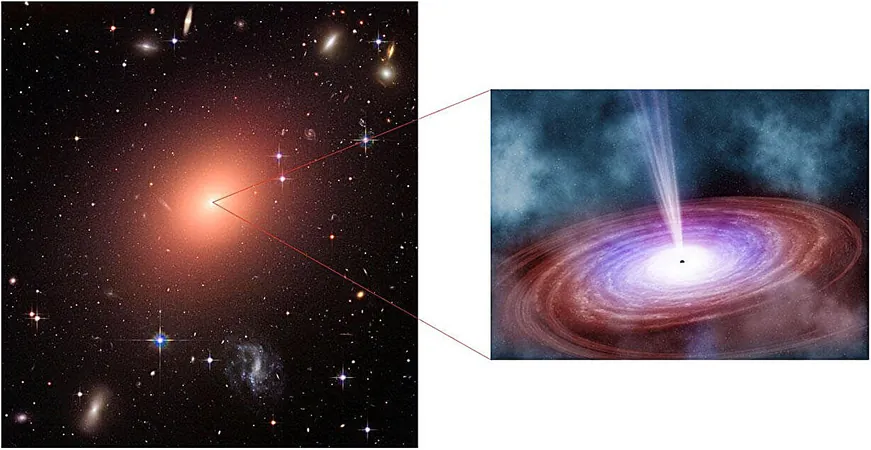
Astronomers Unveil Supermassive Black Holes in ‘Dying’ Galaxies: A Cosmic Revelation
2025-09-18
Author: Li
In a groundbreaking discovery, astronomers have identified active supermassive black holes, or quasars, within some of the most distant galaxies in the universe, using the exceptional capabilities of the Subaru Telescope. This revelation, further analyzed with the James Webb Space Telescope (JWST), sheds light on the co-evolution of galaxies and their central black holes from a staggering 12.9 billion years ago.
The research has shown that while these quasars now reside in massive host galaxies, their star formation activity is significantly dwindling. This key finding hints at the dominant role supermassive black holes played in the formation and growth of the earliest and most rapidly expanding galaxies.
Published in the journal Nature Astronomy, the study combines Subaru's wide-field survey power with the infrared sensitivity of JWST to delve into the remote past of the cosmos.
Supermassive black holes, which can weigh anywhere from hundreds of thousands to tens of billions of solar masses, typically lurk at the hearts of galaxies. Unlike their stellar-mass counterparts, which emerge at the end of a star's life cycle, supermassive black holes are believed to have formed early in galaxy evolution, gradually accumulating mass over cosmic timescales.
When active, these behemoths exude vast energy as they draw in surrounding matter, making them visible as brilliant quasars.
Previous observations have established a strong link between the mass of galaxies and their central black holes, a phenomenon labeled "co-evolution." However, when and how this linked growth commenced remains a mystery. To unravel these early stages, astronomers are eager to analyze distant galaxies and the contributions from both their stellar populations and black hole activities.
An international research team, including members from the Kavli Institute for the Physics and Mathematics of the Universe at the University of Tokyo, observed two exceptionally distant quasars, J2236+0032 and J1512+4422—located a staggering 12.9 billion light-years away, merely 900 million years after the Big Bang—using JWST's Near Infrared Spectrograph.
Discovered through the Hyper Suprime-Cam Subaru Strategic Program, these quasars became a part of JWST's first-year science operations. The team successfully detected not only the brilliant emissions from the quasars but also, intriguingly, the absorption lines of neutral hydrogen from their host galaxies—indicative of their stars.
Detailed analysis of these absorption lines suggested that the galaxies had undergone a dramatic bout of star formation hundreds of millions of years earlier, after which their growth slowed considerably or nearly halted.
The two quasars represent some of the farthest known galaxies at this stage of cosmic history, and the transformation into 'dying' states may be attributed to the intense radiation from their central black holes.
JWST's near-infrared imaging revealed that the host galaxies harbor massive stellar quantities—60 billion and 40 billion solar masses in stars for J2236+0032 and J1512+4422, respectively.
Dr. Masafusa Onoue, the lead author of the study, expressed astonishment: "It was totally unexpected to find such mature galaxies in the universe less than a billion years after the Big Bang. What is even more remarkable is that these ‘dying’ galaxies still host active supermassive black holes."
This pivotal discovery suggests that the activity of supermassive black holes may actively hinder the growth of their host galaxies, steering them from phases of vigorous star formation to relative quiescence. Undoubtedly, this research offers new insights into the complex developmental narrative of galaxies and black holes during the universe's formative years.
As the team continues their meticulous analysis of JWST data, they are also planning future observations to further unravel the enigmatic relationship between galaxies and black holes, marking a proud moment for Japanese astronomy.


 Brasil (PT)
Brasil (PT)
 Canada (EN)
Canada (EN)
 Chile (ES)
Chile (ES)
 Česko (CS)
Česko (CS)
 대한민국 (KO)
대한민국 (KO)
 España (ES)
España (ES)
 France (FR)
France (FR)
 Hong Kong (EN)
Hong Kong (EN)
 Italia (IT)
Italia (IT)
 日本 (JA)
日本 (JA)
 Magyarország (HU)
Magyarország (HU)
 Norge (NO)
Norge (NO)
 Polska (PL)
Polska (PL)
 Schweiz (DE)
Schweiz (DE)
 Singapore (EN)
Singapore (EN)
 Sverige (SV)
Sverige (SV)
 Suomi (FI)
Suomi (FI)
 Türkiye (TR)
Türkiye (TR)
 الإمارات العربية المتحدة (AR)
الإمارات العربية المتحدة (AR)